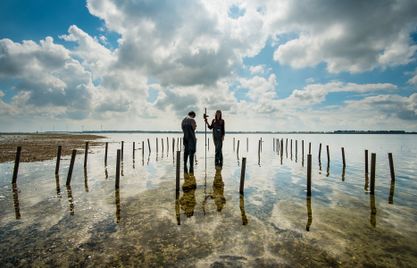PR 00299: verschil tussen versies
Geen bewerkingssamenvatting |
Geen bewerkingssamenvatting |
||
| (6 tussenliggende versies door 2 gebruikers niet weergegeven) | |||
| Regel 1: | Regel 1: | ||
Littoral musselbeds form a very positive addition to intertidal areas. However, due to overfishing, introduced, competing species and climate change these structures have dissapeared within the Eastern Scheldt. Reintroducing littoral musselbeds would give a couple valuable additions to the current landscape. But what is the most effective and efficient way of reintroduction? The 'Added value with Mussels' project looks into different strategies to find out what works best and what the effects of the musselbeds are. The goals of the project are: | Littoral musselbeds form a very positive addition to intertidal areas. However, due to overfishing, introduced, competing species and climate change these structures have dissapeared within the Eastern Scheldt. Reintroducing littoral musselbeds would give a couple valuable additions to the current landscape. But what is the most effective and efficient way of reintroduction? The 'Added value with Mussels' project looks into different strategies to find out what works best and what the effects of the musselbeds are. The goals of the project are: | ||
[[Bestand:MMM.jpg|miniatuur|417x417px|PhD student Jildou Schotanus in the field taking measurements.]] | |||
- Create new, viable production locations for shellfish cultivation | - Create new, viable production locations for shellfish cultivation | ||
| Regel 14: | Regel 14: | ||
'''Contact:''' {{External link|resource=Resource Hyperlink 00709|name=Wietse van de Lageweg|dialog=process-linkwebsite-dialog}} | '''Contact:''' {{External link|resource=Resource Hyperlink 00709|name=Wietse van de Lageweg|dialog=process-linkwebsite-dialog}} | ||
{{Project config}} | {{Project config}} | ||
{{Project | {{Project | ||
|Name=Meerwaarde met Mosselen | |Name=Meerwaarde met Mosselen | ||
|Supercontext= | |Supercontext=PR_00343 | ||
|Start date= | |NameEn=Added value with mussels | ||
|End date= | |Start date=2015/01/01 | ||
|Summary=Musselbanks that stick out of the water during low tide have shown to be a positive addition to the environment. Sadly these structures have decreased or even disappeared over time. Bringing them back would be an improvement for coastal defense (it decreases the erosion in an area), natural value (birds, crabs and other wildlife are often found in these areas with a high food availability) and economy (mussel farmers could use a portion of the plots for cultivating and selling mussels). 'Added value with Mussels' looks at the best strategy to bringing back these types of musselbanks. | |End date=2020/12/31 | ||
|Summary=Mosselbanken die bij eb uit het water steken hebben bewezen een positieve aanvulling te zijn op het milieu. Helaas zijn deze structuren in de loop der tijd afgenomen of zelfs verdwenen. Het terugbrengen ervan zou een verbetering zijn voor de kustverdediging (het vermindert de erosie in een gebied), de natuurwaarde (vogels, krabben en andere wilde dieren zijn vaak te vinden in deze gebieden met een hoge voedselbeschikbaarheid) en de economie (mosselkwekers zouden een deel van de percelen kunnen gebruiken voor het kweken en verkopen van mosselen). In "Meerwaarde met mosselen" wordt nagegaan wat de beste strategie is om dit soort mosselbanken terug te brengen. | |||
|Show summary=Nee | |||
|SummaryEn=Musselbanks that stick out of the water during low tide have shown to be a positive addition to the environment. Sadly these structures have decreased or even disappeared over time. Bringing them back would be an improvement for coastal defense (it decreases the erosion in an area), natural value (birds, crabs and other wildlife are often found in these areas with a high food availability) and economy (mussel farmers could use a portion of the plots for cultivating and selling mussels). 'Added value with Mussels' looks at the best strategy to bringing back these types of musselbanks. | |||
Research type: field research, desk analysis, lab research | Research type: field research, desk analysis, lab research | ||
|Contact person=Gebruiker:Lage0009 | |Contact person=Gebruiker:Lage0009 | ||
|Stakeholder=STKH 00061,STKH 00064,STKH 00069,STKH 00070, | |Stakeholder=STKH 00061,STKH 00064,STKH 00069,STKH 00070,STKH 00114,STKH 00113,STKH 00114 | ||
|Show extra=Nee | |Show extra=Nee | ||
|Show navigation tree=Ja | |Show navigation tree=Ja | ||
Huidige versie van 24 aug 2022 om 14:38
Littoral musselbeds form a very positive addition to intertidal areas. However, due to overfishing, introduced, competing species and climate change these structures have dissapeared within the Eastern Scheldt. Reintroducing littoral musselbeds would give a couple valuable additions to the current landscape. But what is the most effective and efficient way of reintroduction? The 'Added value with Mussels' project looks into different strategies to find out what works best and what the effects of the musselbeds are. The goals of the project are:
- Create new, viable production locations for shellfish cultivation
- Create (alternative) methods that help stabilizing or maybe even decrease erosion rates in intertidal areas
- Adding natural value to intertidal areas to comply with the new Natura-2000 goals set by the Dutch government
The results will be gathered by performing large-scale field experiments in the Eastern Scheldt. Different methods will be tested and the results will be compared to find the most effective way of reintroducing littoral musselbeds.
Research type: field research, desk analysis, lab research
Location: Easternscheldt, Viane, Zealand
Contact: Wietse van de Lageweg

